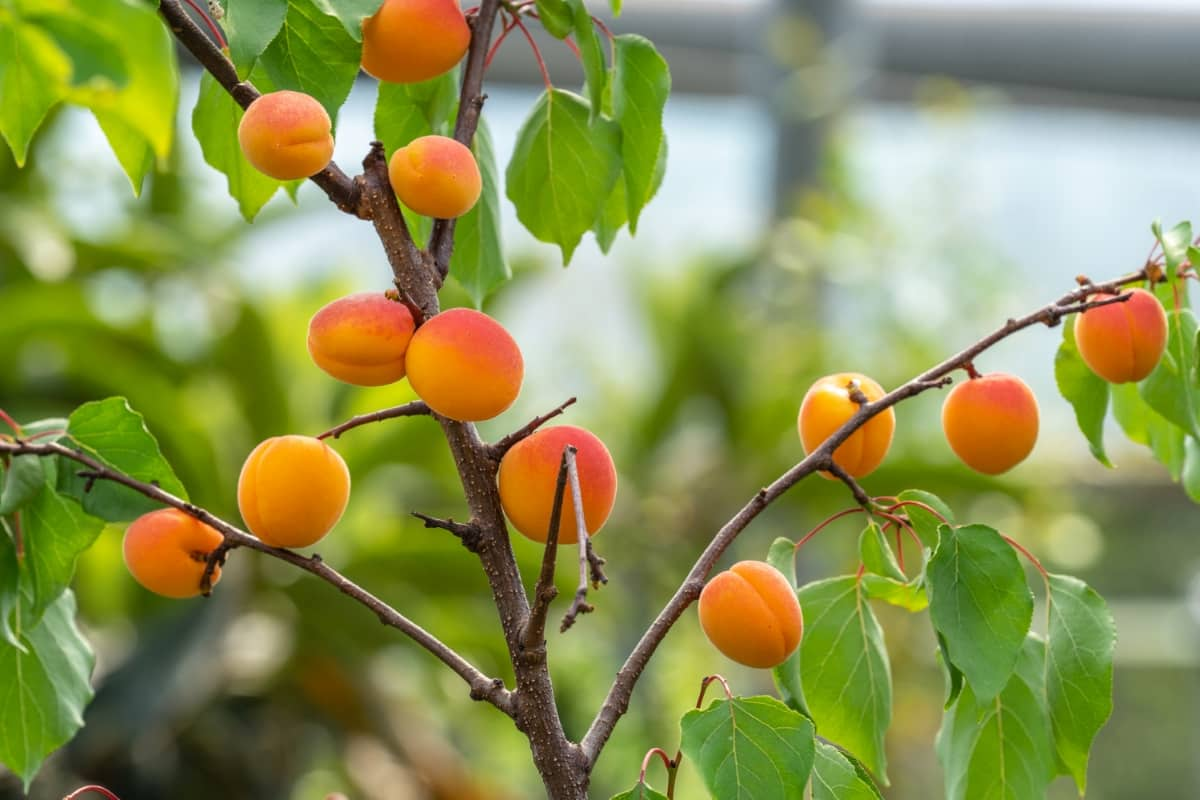Apricot farming is an ancient practice that has been passed down through generations. Understanding the basics of Apricot farming is crucial for anyone looking to start an Apricot farm business. First and foremost, it’s important to know that Apricots thrive in temperate regions with well-drained soil and plenty of sunlight.

Apricots require a minimum of 500 chilling hours per year, which means they need a certain amount of cold weather during the dormant period to produce fruit. When it comes to planting Apricot trees, it’s essential to choose healthy saplings from reputable nurseries. These saplings should be planted in rows with adequate spacing between them for proper airflow and access to sunlight.
Apricots also require regular irrigation, especially during dry periods. Pruning is another vital aspect of Apricot farming. It helps maintain tree health, shape growth, and improve fruit quality. Pruning should typically be done during late winter or early spring before new growth begins. Pollination is significant in successful Apricot production since most varieties are self-unfruitful or partially self-fertile. Cross-pollination from other compatible varieties is necessary for an optimal fruit set.
Apricot Farming Business Plan
Conducting Market Research for Your Apricot Farming Business Plan
Market research lets you gain valuable insights into consumer demand, competitor analysis, and pricing trends. Begin by identifying your target market. Understanding your potential customers’ preferences and buying habits will help you tailor your production and marketing strategies accordingly. Next, analyze the competition in your area. Look at existing Apricot farms or fruit producers and assess their strengths and weaknesses.
This information can guide you in finding a unique selling point for your farm. Additionally, researching pricing trends is crucial as it helps determine the profitability of your Apricot farming venture. Study local markets and online platforms to understand how much customers are willing to pay for fresh Apricots. Consider connecting with potential buyers such as restaurants or bakeries interested in using locally sourced ingredients like Apricots in their products.
Defining Your Apricot Farming Business Goals and Objectives
Consider what you want to accomplish with your Apricot farm. Next, break down these larger goals into smaller, achievable objectives. Suppose one of your main goals is to increase production by 20% within the first year. In that case, one objective could be implementing efficient irrigation systems or adopting sustainable farming practices. Additionally, make sure that your goals and objectives align with market demand. Remember to keep your goals realistic yet ambitious. Setting challenging targets can motivate you to push yourself and continually improve as an Apricot farmer.
Choosing the Right Apricot Varieties for Your Farm
Choosing the right Apricot varieties for your farm is crucial in building a successful Apricot farming business. First and foremost, you’ll need to consider your specific location’s climate and growing conditions. Apricots thrive in areas with cold winters and hot summers, but some varieties are better suited for certain climates than others. Research on which varieties have proven successful in similar climates to ensure they can withstand the weather conditions in your area.
In case you missed it: Irrigation Techniques for Apricot Farming: Best Practices for Water Conservation

Consider the market demand for different Apricot varieties. Some customers prefer sweeter Apricots, while others prefer more tart flavors. Researching consumer preferences and trends can help you determine which types of Apricots will sell well in your target market. Additionally, it’s important to consider disease resistance when selecting Apricot varieties for your farm. Different cultivars have varying resistance levels or susceptibility to common diseases such as bacterial spot or brown rot. Choosing disease-resistant varieties can save you time and money on pest control measures in the long run.
Planning and Designing Your Apricot Orchard Layout
When it comes to planning and designing your Apricot orchard layout, there are several factors that you need to consider. You need to determine the size of your orchard and how many Apricot trees you want to plant. This will depend on the available land as well as your production goals. Next, you should think about the spacing between the trees. The recommended distance between each tree is typically around 15-20 feet apart.
Another important aspect of designing your orchard layout is considering the irrigation system. Apricots need regular watering, especially during dry periods or when they are fruiting. Installing an efficient irrigation system such as drip irrigation can ensure that water reaches the root zone directly without wasting any. Consider any slopes or contours in your land when planning your orchard layout.
Estimating the Initial Investment and Start-Up Costs
When starting an Apricot farming business, it is essential to have a clear understanding of the initial investment and start-up costs involved. This will help you plan your budget effectively and ensure you have enough funds to keep your farm running smoothly. To estimate the initial investment, you need to consider various factors such as land acquisition or lease costs, infrastructure development (including irrigation systems), purchasing Apricot saplings or seeds, equipment for cultivation and harvesting, labor expenses, marketing expenses, insurance coverage, and contingency funds.
The cost of land will vary depending on location and size. Researching local real estate prices or rental rates is important for an accurate estimate. Infrastructure development costs include installing efficient irrigation systems like drip or sprinkler systems. Another significant expense is acquiring high-quality Apricot saplings or seeds from reputable nurseries. Consider the number of trees needed for your orchard layout when estimating these costs.
Developing a Marketing Strategy for Your Apricot Products
Marketing is an important component of any successful business, and Apricot farming is no exception. To ensure the success of your Apricot farm, it’s crucial to develop a comprehensive marketing strategy to help you reach customers and promote your delicious Apricot products. Identify your target market. Next, determine the best channels to reach your audience. Use social media platforms to showcase mouth-watering images of ripe Apricots and engage with potential customers.
You could also explore local farmers’ markets or food festivals as opportunities to connect with buyers who appreciate locally grown produce directly. Another effective marketing tactic is partnering with local retailers or restaurants that share similar values in promoting sustainable agriculture and supporting local communities. Establishing these partnerships can increase your brand’s visibility while reaching a wider customer base.
Creating a Production Plan for Apricot Cultivation
To start, it’s important to determine the ideal growing conditions for Apricots in your specific region. Apricots thrive in areas with mild winters and hot summers, so choose a location that meets these requirements. Next, consider the varieties of Apricots available and select those best suited for your climate and market demand. Once you’ve chosen your varieties, create a timeline outlining key tasks throughout the year.
In case you missed it: Effective Management Strategies for Pests and Diseases in Apricot Orchards

This includes spring activities such as pruning and fertilizing, summer care like irrigation and pest control measures, and fall preparations for winter dormancy. Investing in modern agricultural technology can greatly enhance your production efficiency. Consider implementing drip irrigation systems to ensure proper water management or using netting to protect crops from birds and other pests. Regular monitoring of orchard health is essential. Conduct routine inspections for signs of disease or pest infestation and take prompt action if any issues arise.
Managing Pest and Disease Control in Apricot Farming
Pest and disease control is key to Apricot farming to ensure healthy crops and optimal yields. One key step in managing pest and disease control is to regularly monitor your orchard for any signs of infestation or infection. This includes inspecting leaves, fruits, branches, and the surrounding soil for pests such as aphids, mites, borers, and diseases like brown rot or bacterial spot.
To control pests and diseases, it’s important to maintain good sanitation practices in your orchard. Remove fallen leaves or fruit debris promptly, as they can harbor pathogens or attract insects. Pruning infected branches should also be done carefully to prevent further contamination. Cultural practices like proper irrigation techniques can help reduce stress on Apricot trees, making them less susceptible to pests and diseases. Promoting biodiversity by planting companion plants that attract beneficial insects can also aid in natural pest control.
Financial Projections and Analysis for Your Apricot Farming Business
Once you have laid out your Apricot farming business plan, it’s time to dive into the financial aspects of your venture. You need to estimate your initial investment and start-up costs. Consider expenses such as land acquisition, equipment purchases or leases, irrigation systems, labor, and marketing expenses. By accurately calculating these figures, you can determine how much capital is needed to get your Apricot farm up and running.
Next, develop a comprehensive budget that includes fixed costs (such as land taxes) and variable costs (such as fertilizer or pest control). This will help you keep track of ongoing expenses throughout the year. In addition to estimating costs, it’s crucial to project revenue streams for your Apricot farming business. Consider factors like market demand for fresh Apricots or value-added products like jams or dried fruits. Analyze pricing trends in local markets and explore potential distribution channels such as farmer’s markets or direct-to-consumer sales.
Frequently Asked Questions (FAQ) on How to Create an Apricot Farming Business Plan
What are the Key Elements of a Successful Apricot Farming Business Plan?
A successful Apricot farming business plan should include market research, clear goals and objectives, selection of appropriate Apricot varieties, orchard layout planning, estimated investment, and start-up costs, marketing strategy development, production plan creation, pest and disease control management strategies, as well as financial projections and analysis.
How Can I Estimate the Initial Investment and Start-Up Costs for My Apricot Farm?
Estimating the initial investment and start-up costs requires considering various factors, including land acquisition or leasing costs, fencing irrigation equipment, cultivation tools, saplings, fertilizers, and labor costs.
In case you missed it: Harvesting Apricots: Optimal Timing, Techniques, and Post-Harvest Handling

Conclusion
Apricot farming can be a lucrative and rewarding business venture for those passionate about agriculture. Develop a strong marketing strategy to promote your Apricot farm and reach your target audience. Consider the benefits and challenges associated with Apricot farming, such as weather conditions and pest management, so you are well-prepared for any obstacles.
- Feed Your Flock for Less: Top 10 Tips to Save on Chicken Feed
- Ultimate Guide to Ossabaw Island Hog: Breeding, Raising, Diet, and Care
- Hatching Answers: The Top 10 Reasons Your Chickens Aren’t Laying Eggs
- Eggs and Economics: Breaking Down the Cost of Raising Backyard Chickens
- Defend Your Greens: Proven Methods to Keep Iguanas Out of Your Garden
- Ultimate Guide to Cinnamon Queen Chicken: A Comprehensive Guide for Beginners
- Ultimate Guide to California Tan Chicken: Breeding, Raising, Diet, Egg-Production and Care
- Ultimate Guide to Marsh Daisy Chicken: Breeding, Raising, Diet, and Care
- 10 Types of Chicken Farming Businesses You Can Start for Profits